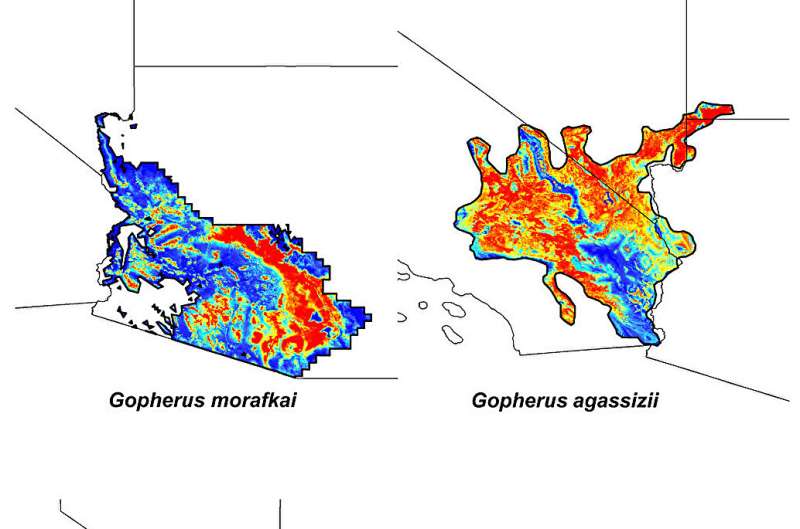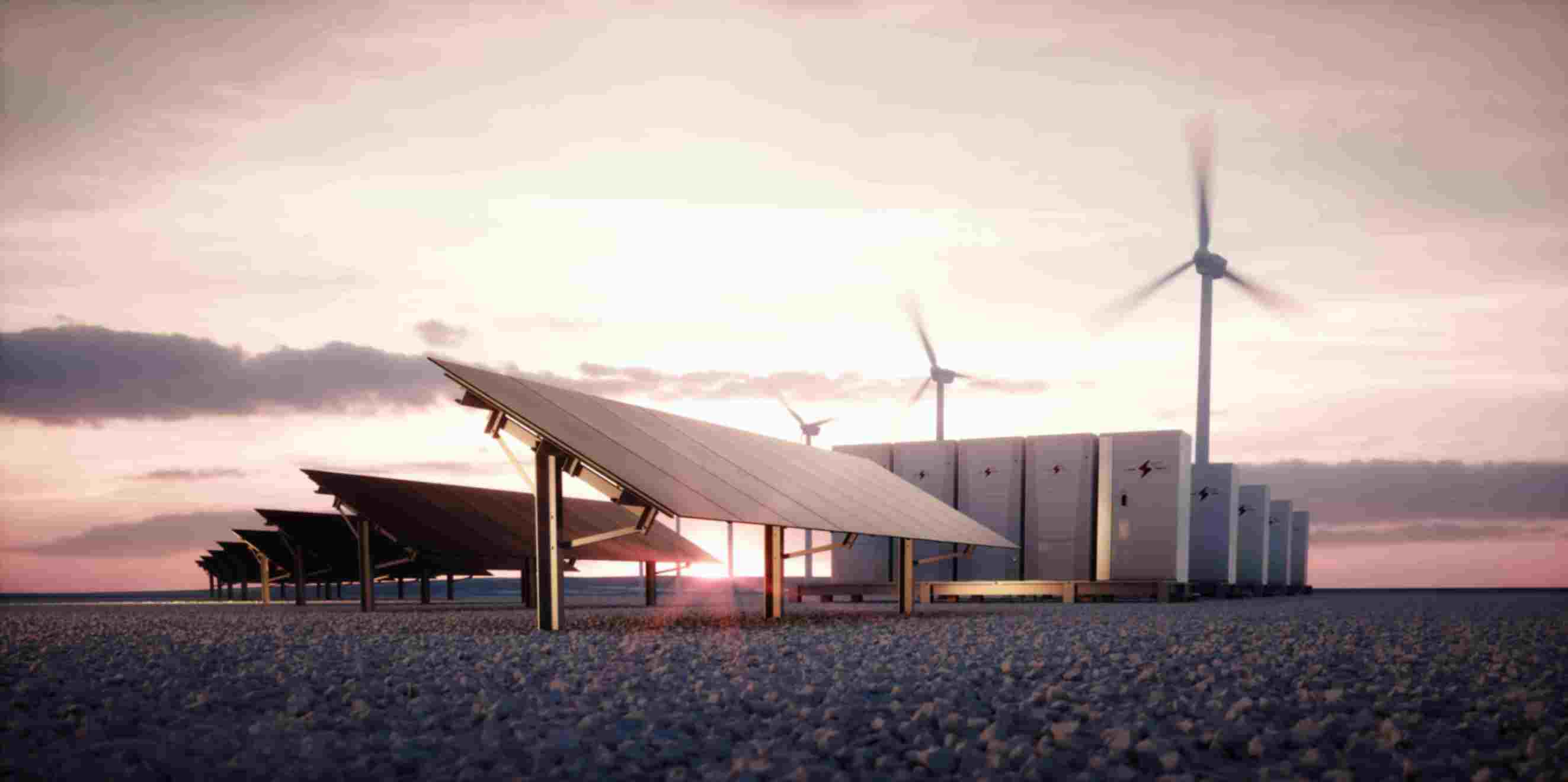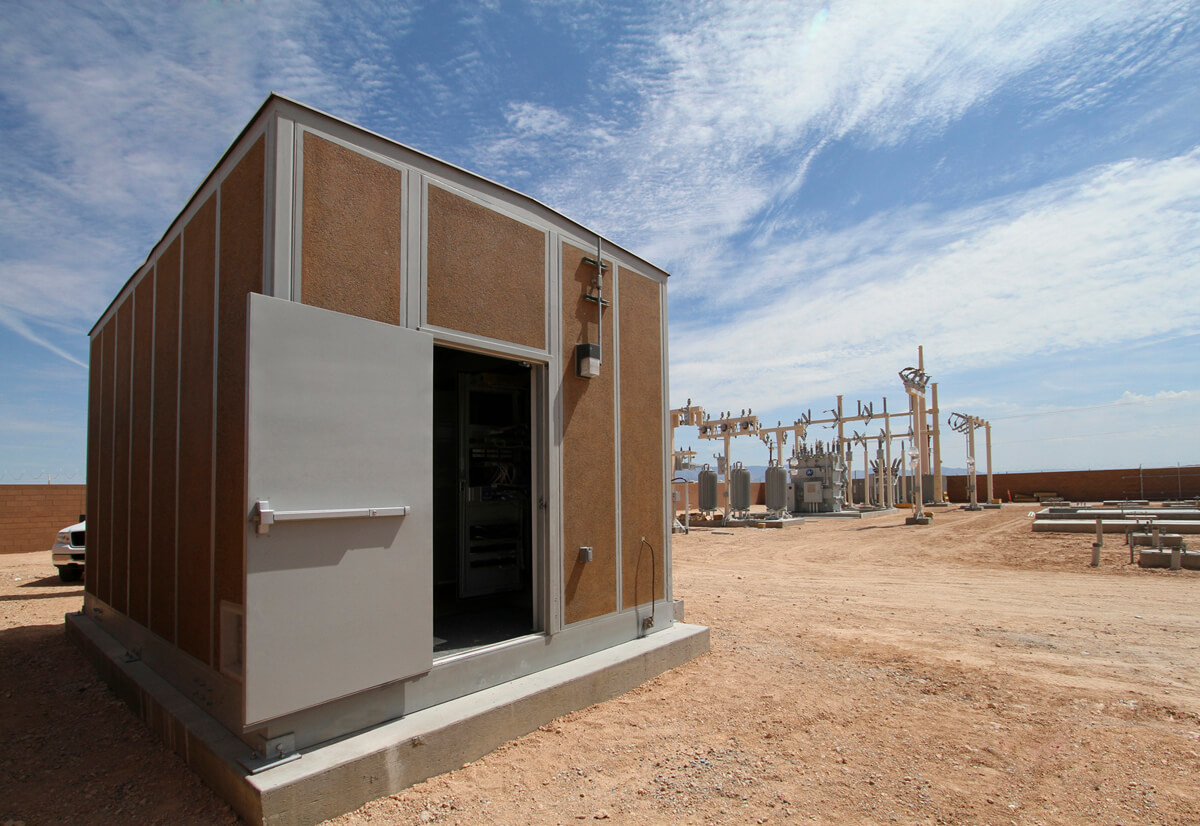Solar
Daniel E. Chartock
Energy Storage
Emerson
Solar
Garth Schultz and Mark Cerasuolo

As the climate crisis accelerates, the urgent transition to renewable energy sources is at the forefront of global sustainability efforts. However, a new study by Kylee Fleckenstein, published in PeerJ, reveals a critical challenge in balancing renewable energy development with biodiversity conservation in the arid Southwest United States.
The research, titled "Mapping species of greatest conservation need and solar energy potential in the arid Southwest for future sustainable development," explores the intersection of high-priority conservation habitats and areas suitable for large-scale Solar Energy Development (SED).

Study extent of the United States Southwest. Study extent includes California, Nevada, Colorado, Arizona, New Mexico, and Texas. Credit: PeerJ(2025). DOI: 10.7717/peerj.18568
With its abundant sunshine and open landscapes, the Southwest boasts some of the highest Global Horizontal Irradiance (GHI) values in the country, making it a prime location for solar energy expansion. However, the region is also home to unique and vulnerable species, including the LeConte's Thrasher (Toxostoma lecontei), Bendire's Thrasher (Toxostoma bendirei), Sonoran Desert Tortoise (Gopherus morafkai), Mojave Desert Tortoise (Gopherus agassizii), and the Southwestern population of the Burrowing Owl (Athene cunicularia).
Fleckenstein's study uses a novel combined approach, employing species distribution modeling (SDM) to map areas of likely species presence and high habitat suitability, alongside a site suitability analysis for potential solar development sites. The findings indicate a significant overlap between high-priority habitats and optimal locations for SED, underscoring the urgent need for strategies that balance renewable energy growth with conservation priorities.
"Our study highlights a paradox: the same landscapes that make the Southwest ideal for solar energy development are also critical for the survival of species that are already facing threats from habitat loss, population growth, and climate change," said Fleckenstein. "This research offers a roadmap for identifying areas where development can proceed sustainably, minimizing impacts on biodiversity."

Habitat Suitability Mapping for Each Target Species within the IUCN resident extant. Habitat suitability for T. lecontei, G. morafkai, and G. agassizii within their respective IUCN ranges. Credit: PeerJ (2025). DOI: 10.7717/peerj.18568
The study provides actionable insights for policymakers, conservationists, and developers, emphasizing the importance of integrating biodiversity conservation into renewable energy planning. By identifying areas of overlap between conservation priorities and energy potential, stakeholders can make informed decisions to support both sustainable development and the protection of the region's unique ecological heritage.
As the U.S. prepares to scale up renewable energy initiatives, particularly solar energy projects, the study calls for a collaborative approach to ensure that renewable energy solutions do not come at the cost of irreplaceable biodiversity.
Key findings include:
This research serves as a call to action for a balanced approach to climate solutions, ensuring that the shift to renewable energy is not only sustainable but also responsible.
Science X | www.phys.org

On December 27, 2024, the U.S. Department of Energy (DOE) released new funding for the Small Business Innovation Research and Small Business Technology Transfer (SBIR/STTR) Phase I program for Fiscal Year 2025. The SBIR/STTR programs are competitive funding opportunities that encourage U.S.-based small businesses to engage in high-risk, innovative research and technology development with the potential for future commercialization. See the Solar Energy Technologies Office’s (SETO) SBIR/STTR funding notice for details on SETO topics.
SBIR/STTR provides funding in two phases: Small businesses can receive up to $200,000 in Phase I to prove the feasibility of an idea; successful awardees can then receive up to $1.1 million in Phase II for prototype development.
Mandatory letters of intent for this funding opportunity are due January 14 at 5 p.m. ET. Please review the funding opportunity and the technical topics document for more information – register to attend tomorrow's Q&A session at 2 p.m. ET.
Through SETO, SBIR/STTR funding is awarded to companies that are working to advance the affordability, reliability, and performance of solar technologies on the grid. SETO seeks solutions in the following subtopics:
SETO, through the American-Made Network, is providing free Application Education Services. Learn more.
DOE | www.doe.gov

The Public Utilities Commission of Nevada (PUCN) has issued a final order regarding NV Energy's 3-year resource plan that takes a positive step forward by holding NV Energy accountable and valuing distributed energy resources, such as local solar and storage, as cost-effective measures.
In the order, the PUCN mandates more regular and substantial stakeholder interactions, aiming to ensure that resource planning is thoroughly discussed and feedback is incorporated. Additionally, NV Energy has been directed to enhance its reporting on behind-the-meter (BTM) storage in future Demand Side Management (DSM) updates and to incorporate additional benefits of local energy resources into the upcoming Distributed Resource Plan (DRP) update in September 2025.
"The Public Utilities Commission of Nevada's recent order represents a pivotal moment for clean energy in our state, setting a standard for accountability and inclusivity in resource planning,” said Vote Solar’s Interior West Regulatory Director, Claudine Custodio. “By valuing distributed energy resources, like local solar and storage, and amplifying stakeholder voices, we are not just paving the way for a sustainable future but also ensuring that all Nevadans benefit from a cleaner and more resilient electric grid.”
The PUCN has agreed with Vote Solar’s recommendation for adjustments to NV Energy's analysis, including extending the evaluation period to 20 years and considering factors like system losses and tax implications. These directives underscore NV Energy’s need to rectify past oversights and be transparent in its planning process to better provide for ratepayers under their services.
"While this recent order makes us hopeful about the direction the PUCN is going in, our work in Nevada is nowhere near done,” said Custodio. “The approved new gas plants and limited transportation electrification plan budgets within the order are reminders that there is still much to improve. We will continue pushing our advocacy forward and help guide Nevada towards a cleaner and fairer future.”
Vote Solar | https://votesolar.org/

Solvari is excited to announce that we have signed a contract with a financial platform company to implement a marketplace for our customers to finance their Solvari systems directly through our website. The marketplace will provide a wide array of financing options, including personal loans, solar loans, and solar PPAs. With no dealer fee options and solutions designed for low to medium credit scores, we believe our marketplace will make solar energy more accessible to homeowners.
Financing plays a pivotal role in residential solar adoption with nearly 85% of systems being financed. Solvari made this strategic investment to ensure our partners can offer financing vehicles that are competitive and have simple, clear, and transparent terms that their homeowners can understand.
This investment constitutes the first phase of Solvari’s initiative to provide a seamless comprehensive ecosystem to support our business partners and homeowners/property owners with every step of the sales and installation process.
“We believe that Solvari’s technology simplifies the installation and business operations to such a degree that many new home service companies will start offering solar. However, for these businesses to be successful, they need backend tools specialized for doing the sales proposal, system design, permit package, and financing aspects of solar.” – Samuel Truthseeker, CEO of Solvari
Removing unnecessary and time-consuming steps in the solar purchasing process for both installers and homeowners is not only a primary goal of Solvari but is also aligned with our “Solar Made Easy” ethos.
Solvari | https://www.solvarisolar.com/

POWR2, a global leader in mobile battery energy storage solutions, is proud to announce a year of remarkable achievements and significant contributions to advancing clean energy solutions worldwide. The POWRBANK, POWR2’s award-winning battery energy storage system (BESS), is helping businesses meet their sustainability and profit goals in over 21 countries.
Global Partnerships
2024 marks a pivotal year for POWR2, as they forged key relationships with leading global companies to deliver zero-emission portable power systems to diverse markets including construction, equipment rental, events, and disaster relief. These collaborations include working closely with Powershift Technologies in Australia, New Zealand, and the Pacific Islands; Armorum Limited in Ireland; GeniWatt and Eiffage Construction in France; Altaaqa Alternative Solutions in the Middle East; and Nishio Rent-All in Asia.
Innovative Product Launches
This year marked the launch of ADVANTAGE by POWR2, a revolutionary energy management system designed to optimize energy efficiency, reduce operational costs, and maximize the performance of POWRBANKs.
Responding to increasing market demand, POWR2 also ramped up production of the POWRBANK MAX, a 250kVA+ battery energy storage solution engineered for large-scale applications in industries including but not limited to construction, mining, and chemical refining.
Industry Leadership
POWR2 successfully launched a podcast, Leading the Charge, where industry leaders and experts discuss the latest trends, challenges, and opportunities in the renewable energy sector. The podcast has quickly become a valuable resource for industry professionals, offering unique insights into the promising future of clean energy solutions.
Fuel Efficiency and Environmental Impact
POWR2’s commitment to sustainability remains at the core of its operations. Since launching in 2018, POWRBANKs have helped save over 724 million pounds of CO2 emissions by eliminating the need to burn over 32 million gallons of diesel fuel. This milestone underscores POWR2’s dedication to providing energy solutions that help companies lower fuel usage, increase efficiency, and reduce negative environmental impact.
ABOUT POWR2

FranklinWH Energy Storage Inc. (FranklinWH), a leader in whole-home energy management, announced the general availability of its next-generation whole home energy management solutions, including the aPower 2, a lithium iron phosphate (LFP) home battery featuring an impressive 15 kWh capacity and 10 kW continuous output power, as well as its enhanced aGate, an intelligent management device that supports home loads by integrating energy sources and FranklinWH batteries, and the user-friendly FranklinWH App.
"We are proud to begin delivering our next-generation whole-home energy management system to homeowners at such a critical time," said Gary Lam, Co-Founder and CEO of FranklinWH. "In addition to a seamless connection with PV inverters, these upgrades demonstrate our commitment to constant improvement and providing consumers with peace of mind amid rapidly growing energy demand and extreme weather events."
FranklinWH's whole home system is available via its growing installer network, composed of more than 2,000 installation companies located across the U.S., including Puerto Rico. Domestic Content compliant versions of the aPower 2 are expected to be available to customers in Q2, 2025.
New enhancements to the FranklinWH whole home solution were made to further meet homeowner needs. Along with an increased warranty of 15 years or 60 MWh throughput, FranklinWH's upgraded system provides even greater reliability and return on investment for homeowners. Whole home backup can be achieved, in most cases, with a single aPower 2 due to its robust 15 kWh capacity, 10 kW discharge rate, 8 kW charge rate, and support for up to 5-ton AC units. For larger applications, the aPower 2 can be stacked up to 225 kWh or 15 aPowers per aGate. Enhanced black start capabilities and a more efficient low-power mode make the system the ideal solution in backup power situations – ensuring power is available when a homeowner needs it most.
FranklinWH's solutions can endure almost any climate and, by using fan-less convection with whisper-quiet operation, it is significantly quieter than industry-standard fan cooled batteries. The FranklinWH App has been enhanced with revamped visuals, a smart voice assistant for hands-free commands, enhanced energy data analysis, and more customized scheduling options so homeowners can take further control over their energy usage.
FranklinWH | www.franklinwh.com

Enstall has now closed on a transaction to acquire Schletter Group, marking a significant milestone for both companies and the solar sector at large.
This deal unites two leaders in the solar mounting space, combining engineering expertise and pioneering products with global reach and extensive service network with the joint goal being to accelerate the worldwide adoption of renewable energy through enhanced physical and digital product offerings and even greater all-round value to customers.
Schletter’s CEO, Florian Roos, welcomes the acquisition. “We’re thrilled to join the Enstall family. Together, we’ll leverage our combined strengths to expand our global reach and continue supporting the world’s renewable energy transition. For Schletter, this is an exciting new chapter—one that will enable us to scale our operations and serve our global partners even better.”
The integration of Schletter into the Enstall family will strengthen both companies’ positions as leaders in solar mounting. Customers can expect superior service capabilities, a broader range of highperformance products, and increased investment in research and development to satisfy the sector’s ever-evolving needs.
Beyond business growth, the acquisition underscores a commitment to tackling the world’s energy challenges head-on. By combining resources, Schletter and Enstall are raising the bar for sustainability and innovation, and reinforcing the role of solar as a cornerstone of the global energy transition.
Both companies are now collaborating closely to ensure a seamless transition that benefits employees, customers, and stakeholders alike.
The Schletter Group | www.schletter-group.com
Energy Storage Dec 28, 2024
2024 finally marked the return to a "normal" consumer auto market. After four years of turmoil, car buyers no longer face inventory shortages or long waits for their preferred vehicles. While many factors contributed to the auto market i....



As clean energy adoption continues to grow, the logistics of retrofitting existing buildings for solar energy have become an important topic for homeowners looking to reduce their carbon footprint and capitalize on financial incentives. Retrofitting,....
When you spend most of your time talking to farmers and folks in rural America, the biggest thing you’ll learn is this: It is harder than ever to be a farmer. In a business with already razor thin margins, equipment and supplies have significantly ....
Around 20-30 percent of solar installations are impacted by main panel limitations. NEC’s 120% rule often necessitates expensive main panel upgrades, potentially costing $2,000 to $5,000 or more with labor, permitting, and additional electrical wor....
Back in 2015, America planted the seeds ....
When the shift to clean and more renewab....
In the quest for sustainable energy, win....
2024 finally marked the return to a "normal" consumer auto market. After four years of turmoil, car buyers no longer face inventory shortages or long waits for their preferred vehicles. While many factors contributed to the auto market i....
Power grids are fundamental to the energy supply for commercial and residential electricity. There is growing energy demand around the world, and more renewable energy sources are being built all the time. Unfortunately, many existing grids and trans....
Diversified, safe, and domestically-produced energy storage is vital for a sustainable and secure future. North America must look beyond lithium and invest in alternate chemistries that complement existing batteries and provide alternatives for grid-....
It’s a fact of life in industrial processing that in order to accomplish “good” things you must sometimes have to work with potentially “bad” things. Such is the case with liquid hydrogen, or LH2. As the industrial world continues to look f....
Transitioning away from a fossil fuel-based society will drastically increase demand for metals used in clean energy technologies. As a result, many of these metals, including nickel, cobalt, graphite, lithium, copper, and the rare earth elements (RE....
The renewable energy landscape is changing rapidly. Advances in technology are powering a green energy renaissance in general, and many alternative power sources are being enhanced, developed, and promoted. These breakthroughs can be anticipated to h....